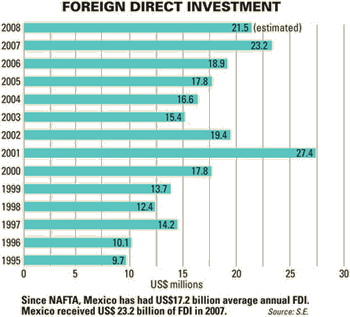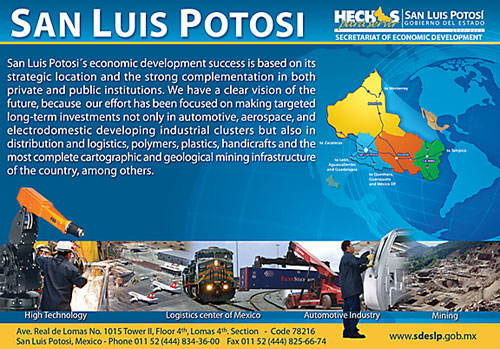ore Mexico in the world and more of the world in Mexico,” was Felipe Calderon’s challenge as he entered his term as President of Mexico.
There is no doubt that President Calderon and his administration is business friendly. The Mexican Government is moving ahead with aggressive plans to invigorate the Mexican economy, with the introduction of a newly formed investment promotion agency ProMexico and an infrastructure improvement plan that will spend US$50 billion each year between 2007 and 2012 on much needed infrastructure upgrades.
Links between the U.S. and Mexican economies are strong and getting stronger. Many Americans realize how important the U.S. is to Mexico’s economy, but the fact is that Mexico is extremely important to the U.S. economy as well. It’s been said that when the U.S. sneezes Mexico catches a cold, but as Mexico’s economy continues to strengthen and diversify, the two economies will become increasingly dependent on each other.
The economies of border states such as Arizona, New Mexico, California, and Texas, depend on commerce with Mexico and on Mexican tourism dollars. Consider the State of Arizona, which averages approximately US$9 billion in commercial transactions with Mexico each year. Almost US$2 billion of this is attributed to spending by Mexican tourists.
With a population of 110 million people, the Mexican market is an important trade partner for the US. In 2006, Mexico’s GDP growth was 4.8 percent. The World Bank ranked it among the top 10 most reformed business environments from 2005 to 2006.
Mexico’s standing in the World Economic Forum’s competitiveness ranking has fallen as a result of China’s competition. Perhaps more than any other nation, Mexico is feeling the effects of the ‘China factor’. That being said, many believe that China’s star has lost a bit of its luster due to a number of issues, a few of which are logistics/shipping and quality related.
American companies are looking at near-shore options again, with their decisions being influenced by cost considerations such as shipping/transport, inventory savings, and more supply chain options – the need to get products to market faster than any other time in history.
There is no doubt that product life-cycles have drastically decreased, so supplies of updated and new products is more critical than ever. Add to the mix distance and business culture, and Americans find it much easier to do business in Mexico.

Bottom lines indicate that Mexico is a solid option for U.S. companies and increasingly foreign companies. After Brazil, Mexico is the largest recipient for foreign direct investment in Latin America and the Caribbean.
In 2007, A.T. Kearney ranked Mexico No. 9 in attracting foreign direct investment, not all of which is American. As large European manufacturers move to leverage the limping dollar, companies such as Vokswagen are looking at facility options in North America and Mexico is a prime candidate.
The Mexican proposition isn’t limited to manufacturing. Mexico is Latin America’s largest pharmaceutical market and is ranked 10th in the world. Mexico has three technological parks in Monterrey, North Mexico, two in Guadalajara, West Mexico and two new ones in Puebla and Quer?taro in the center of Mexico. ??
Mexico has several growing regional industry clusters that demonstrate sector strength. The most dominant of these sectors are:
• North, Tijuana: Strong hardware manufacturing area. There is a strong trade link and partnership between San Diego in the U.S. and Tijuana.
• West, Guadalajara: Strong software development cluster, particular drivers/software for hardware.
• Center, Mexico City: Mainly software applications e.g CRM, ERP (Enterprise resource programming), business intelligence and telemarketing applications.
• South East, Yucatán/Merida: Administrative software applications.
Two industry sectors in Mexico characterize the rise of Mexico’s economic competitive position, ICT and Biotechnology/Pharma. The combination of efforts of government and innovation demonstrated by Mexican industry have culminated in dynamic growth and the diversity of the country’s economic proposition.
?
The Mexican ICT Sector grew 13 percent from 2005, and is currently valued at US$3.6 billion. Approximately 43 percent is made up of technology integration activities, 27 percent by outsourcing, and 26 percent by maintenance and support in the installation of technology infrastructure. The remaining is attributed to training.
Approximately 28 percent of Mexican households have computers, which was underpinned by computer financing initiatives from Telemex and Grupo Elektra. Seventeen percent of Mexico’s households have Internet access.
Mexico has the lowest rates of all the OECD countries for fixed and mobile telephony. The Economist placed Mexico 35 out of 65 countries for e-readiness for business in 2005. It came second out of all Latin America behind Chile.
Jalisco is generally thought of as the IT state and Guadalajara as Mexico’s Silicon Valley. There are 151 small businesses in Jalisco developing software and 2,000 software developers in total – over 90 percent of companies in Mexico are SMEs. The ICT sector in Mexico is gaining momentum so quickly, that many foreign governments are now pursuing outbound investment from Mexico. Don’t think that the Mexican economy is dominated by agriculture and manufacturing: the Mexico of 2008 is a savvy, innovative, and creative economy.
Biotechnology is a relatively new sector in Mexico, with many niche sub-sectors. In general terms, the sector is divided into typical sub-sectors such as food and beverage, environmental, health (human and veterinary), agricultural and industrial.
Regional biotechnology clusters in Mexico include:
• Biocluster Occidente, in Guadalajara, was formed a year ago and groups together Laboratorio Sofia, which specializes in Opthamology, the University of Guadalajara, the ITESO and the Tecnologico de Monterrey in Guadalajara.
• Biocluster del Norte, in Monterrey, is led by Dr. Hugo Barrera, one of the main organizers of the BioMonterrey event. The cluster has a relationship with Texas A&M and the Tecnologico de Monterrey. It is very new, but the idea is very much the same.
One of Mexico’s areas of excellence where Mexico has carved out a niche for itself is in the anti-venoms market, where Bioclon, a medium sized company incorporated by the pharmaceutical Grupo Silanes, is a world market leader.
The major research institutions tied to the sector are the National Autonomous University of Mexico (UNAM), the Cinvestav, the National Politecnic Institute (IPN) and the Tecnologico de Monterrey, the only one of these which is private. All of these have dedicated Biotechnology research departments which have links with industry, having collaborated on projects with Silanes, Gruma, GlaxoSmithkline, Probiomed and Schering.
The biotech/pharmaceutical industry’s future in Mexico is bright. It has the highest growth rate for the pharmaceutical sector in the Americas at 12 percent. It exports 12.1percent of the total pharma market of the Americas, ranking third, just behind the U.S. and Canada but ahead of Brazil. Mexico ranks fifth in the Americas for the Generics market, with a 2.8 percent share.
Mexico is currently the largest pharmaceutical market by sales value in Latin America, having recently taken the lead from Brazil. Worldwide, it is the 10th leading pharmaceutical market. In 2007, the market is valued at around US$13.2 billion, equivalent to US$122 per capita.
Mexico’s economic offer isn’t limited to value and cost based manufacturing, the country is quickly becoming competitive in research and development, especially in niche disciplines in biotechnology and ICT. The fact is that Mexico is a contemporary economy, quickly shedding its old-world ‘developing nation’ perception.
Its position as a valued trade partner to the U.S. can’t be underestimated. Mexico is a vital part of the machinery of the U.S. economy, linked not only by proximity but by vibrant cross-border trade, tourism, and investment.
Sources:
ICT Diffusion to Business: Country Report Mexico, Published June 2006 by OECD
Episcom World Pharmaceutial Market Intelligence Book, 2007
Source: Episcom Business Intelligence, 2006

